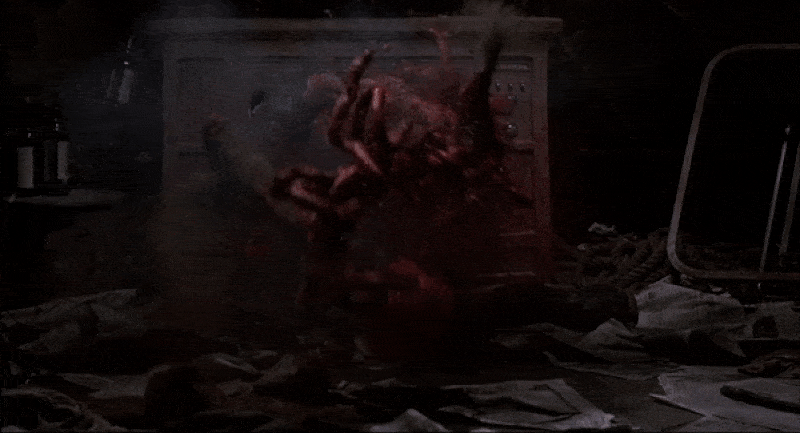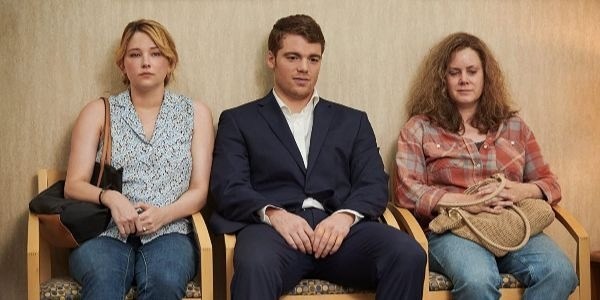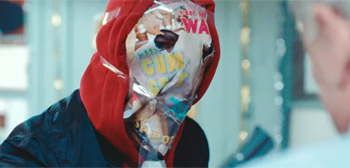How They Did the “Breathing Television” Effect in ‘Videodrome’
Welcome to How’d They Do That? — a bi-monthly column that unpacks moments of movie magic and celebrates the technical wizards who pulled them off. This entry looks into the breathing television effect in Videodrome.
When David Cronenberg directed Videodrome in the early ’80s, he was coming off of a series of fiercely original indie horror films largely financed under Canada’s favorable tax-shelter laws. While Videodrome began life as a tax-shelter picture, early in production the project was picked up by Universal Studios. Working under more commercial auspices had drawbacks. But it also meant that Cronenberg was working with a much larger effects budget. Which, in the hands of the Baron of Blood, certainly did not go to waste.
Videodrome follows Max Renn (James Woods), a small-time porn mogul who’s on the hunt for “tougher” programming. One of his minions dredges up a pirated broadcast of a plotless torture session called “Videodrome.” Sensing he’s on to something that could redefine entertainment, Max searches for the creators of the program. However, with each exposure to the Videodrome signal, Max’s grip on reality begins to blur into something entirely new…and fleshy.
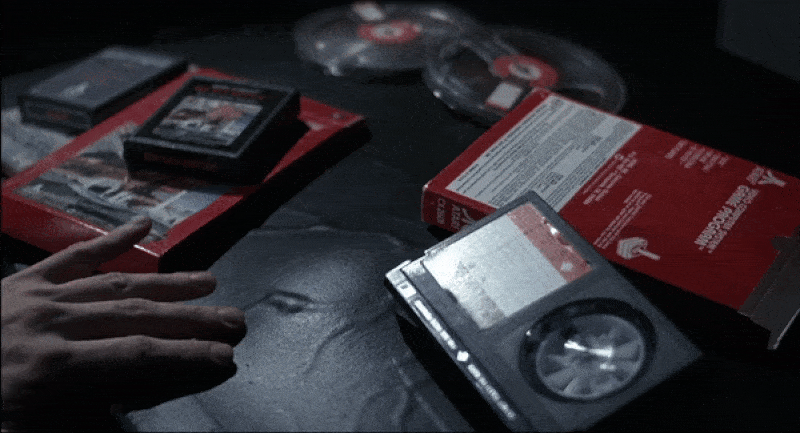
Cronenberg was only a child when television first started to ingratiate itself into people’s homes. Anxious parents warned their children not to sit too close, fearing some pernicious radiation might affect attentive minds. In a video-interview with Mick Garris, Cronenberg underlines that “it’s totally misleading” to describe Videodrome as a criticism of television. “It’s really an extension of what I’ve been doing all along,” explains Cronenberg. “Which is to see what happens when people go to extremes in trying to alter their total environment to the point where it comes back and starts to alter their physical selves.”
In other words, Videodrome is interested not in any Michael Crichton-esque conflict with science and technology so much as in initiating a conversation about how we don’t always know what we’re building or how it’s affecting us. How media shapes our perception of reality, and in so doing actually changes reality for us. How mass media can become a literal outgrowth of our psyches and vice versa.
Long before interactive screens look over our lives, Videodrome envisioned a world where we wouldn’t just look at our devices, they’d look back at us. Where we’d touch them and, in turn, they’d touch us back.

One of the central images in the film is of a swelling television screen engulfing a man’s head. In the scene, Max receives a tape from his secretary (it’s actually Betamax, Videodrome’s format of choice). After the tape swells unexpectedly in his hand, Max drops it to the floor. Finally, he regains his composure and plays the tape. On-screen, he sees media philosopher Marshall McLuhan—sorry: Brian O’Blivion (Jack Creley).
As O’Blivion warns Max that Videodrome is responsible for his death, a masked figure appears and strangles him. The figure removes their mask to reveal the visage of Max’s lover, Nicki Brand (Debbie Harry). The television begins to throb with leathery veins and unprecedented musculature. Brand’s televised lips pucker as the screen swells, her suggestive voice luring Max closer. Finally, Max caresses the screen and pushes his face into her swollen mouth.
It is a compellingly disturbing scene in a film full of compellingly disturbing scenes. It is erotic in a way that somehow defies and rhymes with what conventionally registers as erotic. And, moreover, it is a remarkable and alarming special effect. Like Max, you might gape at the TV to verify that yes, that screen is in fact getting bigger. Glass metamorphosed into something stretchy and organic, that continues to convey a moving-image, unimpeded. So, while Max seems to have no difficulty, it’s a hard effect to wrap your head around. So let’s get into it:
How’d they do that?
Long story short:
A film camera shot footage of a TV screen playing a video of Debbie Harry. This film was then rear-projected onto an inflatable airtight rubber chamber inside the television.
Long story long:
The “breathing screen” effect initially fell to the special makeup effects team. This consisted of Rick Baker and his small army of EFX inc. artists who had an average age of twenty-three. Ultimately, the effect became a collaboration between all three special effects units — makeup, physical, and video.
As Baker tells it, after the success of An American Werewolf In London, the assumption was that special effects makeup artists could do anything the script called for. “I got the script for Videodrome, and it had all this crazy-ass stuff in it,” recalls Baker in a 2012 interview with Den of Geek. “I was like, ‘How the hell am I going to do this?’” In the Criterion bonus audio interview Effects Men, Baker describes Videodrome as “one of the strangest assignments [he’s] ever had.”
The television itself is a TeleRANGER model. Baker and Cronenberg chose it because its size was large enough to accommodate the workings for a mechanical effect. The team built a number of models over the course of production for different effects and for testing.
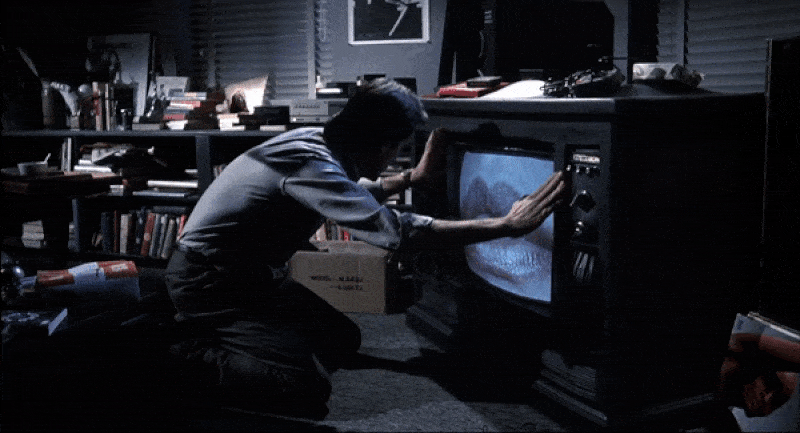
Baker experimented with various approaches for the screen effect. “I knew we would need a flexible material,” he recalls to Criterion. “And we tested with a weather balloon first, stretching it over a frame the size of a TV screen, and pushed a hand through it to see how far it stretched.”
According to the head of special video effects, Michael Lennick, the television prop required a lot of testing. “We were originally going to do it as a bluescreen effect,” he explains. “We were looking up various types of material…blue gelatin was one substance that we were working with, in which the actor could literally dunk his head into this stuff.” Unfortunately, before they could waterboard James Woods with Jell-O, they came up with a more elegant solution.
The suggestively heaving screen was ultimately created with a projector and a sheet of dental dam coated with highly reflective white paint. If a television screen made out of a common barrier for oral sex feels too Cronenbergian to be true, that’s because it is. As Baker reminds us, dental dam rubber was one of the first materials used for rear-projection screens: “It’s what they used in King Kong…It was a nice sensual thing that [Woods] could caress, and it would respond.”
The effect had “a tactility you don’t get with computer imagery,” Cronenberg muses on the commentary. It “allowed you to […pause…] handle things on the set.” Or, as Woods evocatively puts it on his commentary track: the screen was “literally like a big breast.”

Pre-filmed video footage of Harry was rear-projected through an airtight plexiglass chamber onto the sheet of rubber, which in turn could be inflated with a bellows. Speaking of which: the effect called for certain parts of the television to expand and contract. Baker’s team had always used simple cable and pressure controls to puppeteer live performances. Airflow was often regulated by blowing air through an assortment of tubes. But the TV proved too large and complex for this approach.
Physical effects supervisor Frank Carere devised a solution. To grossly oversimplify, Carere outfitted a keyboard organ with a valved air compressor. The result was a device that could inflate air bladders in sequence when the operator pressed certain keys.
Cronenberg shot Videodrome in Toronto in the late fall of 1981. And because Canadian government-funded films were beholden to non-negotiable cut-off dates, production had to wrap by the end of the calendar year. As a consequence, Cronenberg and his crew had to start shooting without a finished script. To be clear: Cronenberg did have a complete script when filming began. But it was, in a manner of speaking, a prototype. Albeit a wilder, more audacious, and by all accounts more shocking prototype.
Several effects set pieces were cut, including one involving our good pal the TeleRANGER. The sequence would have seen a return to one of Cronenberg’s preferred locations: the bathtub. The hallucination required the SFX team to waterproof the television, which, according to the script, was to rise improbably out of the depths of the tub.
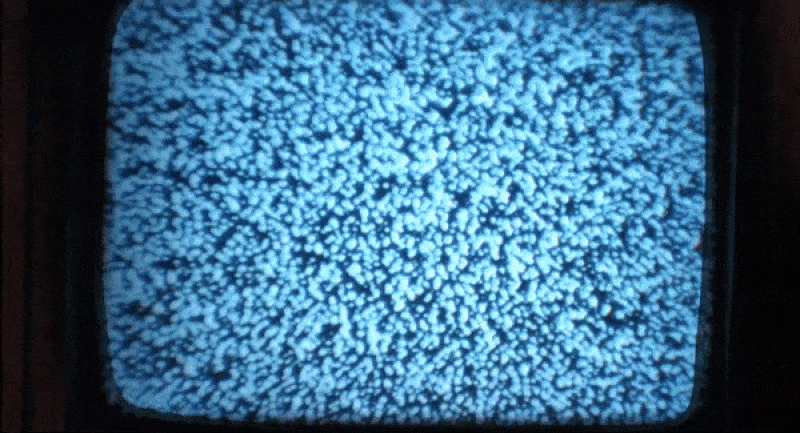
The TeleRANGER does appear in a later effect in the film in a sequence where a hand, clutching a gun, juts out from behind the screen. The transitional effect, shifting between a real video image and a flesh-TV appliance, is relatively straightforward. Baker and his team built a variant of the breathing screen.
Meanwhile, Lennick and his assistant, Lee Wilson, figured out a front projection process that featured a series of graduated filters that allowed the operators to fade-in and -out an image of video static without expensive post-production optical matting. Then it was just a matter of pushing the finger puppet forward in synch with the projected visuals.
Indeed, in addition to looking better than an optical effect, the benefit of pulling off the TV-screen effects in-camera was that the effect was done once shooting wrapped. After all: the hope of the effects team was that they’d get to go home by Christmas — which some of them did, barely.
What’s the precedent?
By Rick Baker’s estimation, most of the effects in Videodrome had no precedent. And around these parts, we’re liable to believe Rick Baker when it comes to the history of makeup effects. We’ve already covered the ins and outs of rear-projection on this column. So in an absence of preexisting piano-controlled dental dam televisions, let’s have a quick chat about Cronenberg’s philosophy around special effects.
When folks think of Cronenberg, they think about his infamous irreverence for the human body. From the vampiric appendage that grows out of Marilyn Chambers’ armpit in Rabid, to the exploding head in Scanners, to Samantha Eggar’s mutated external womb in The Brood: Cronenberg’s filmography offers no shortage of icky, memorable moments.
And yet, while Cronenberg’s career-long interest with untrustworthy flesh is legendary, his films are never about the effects themselves. Not really. Despite how vividly Cronenberg’s creations stick in one’s mind, their impact is as much narrative as it is material.
Which is to say: while their appearance is certainly evocative and compelling, Cronenberg frames his effect in a context that’s meant to make us both uncomfortable and empathetic. You don’t “enjoy” effects in a Cronenberg film as an objective third party. In fact, more often than not, we experience effects in a Cronenberg film from the same pained perspective as the characters.
In her book Deleuze and Horror Film, Anna Powell asks, “Is there really a clear distinction between the ‘props’ and the actors that inter(act) with them in Videodrome? When the television screen softens and bulges…can we really refer to it solely as a prop?” It’s a fair question. This prop is indeed a monstrous one. And it is monstrous precisely because it feels human in its unfolding mutations: from a seductive female form to a tortured body, to finally, a bloated mass of bleeding organs.
The television effects in Videodrome are an enticing confluence of hard and soft, aluminum and flesh, consciousness and hallucination: a cancerous mass of contradictions, alive, breathing, and quite the sight to behold.
